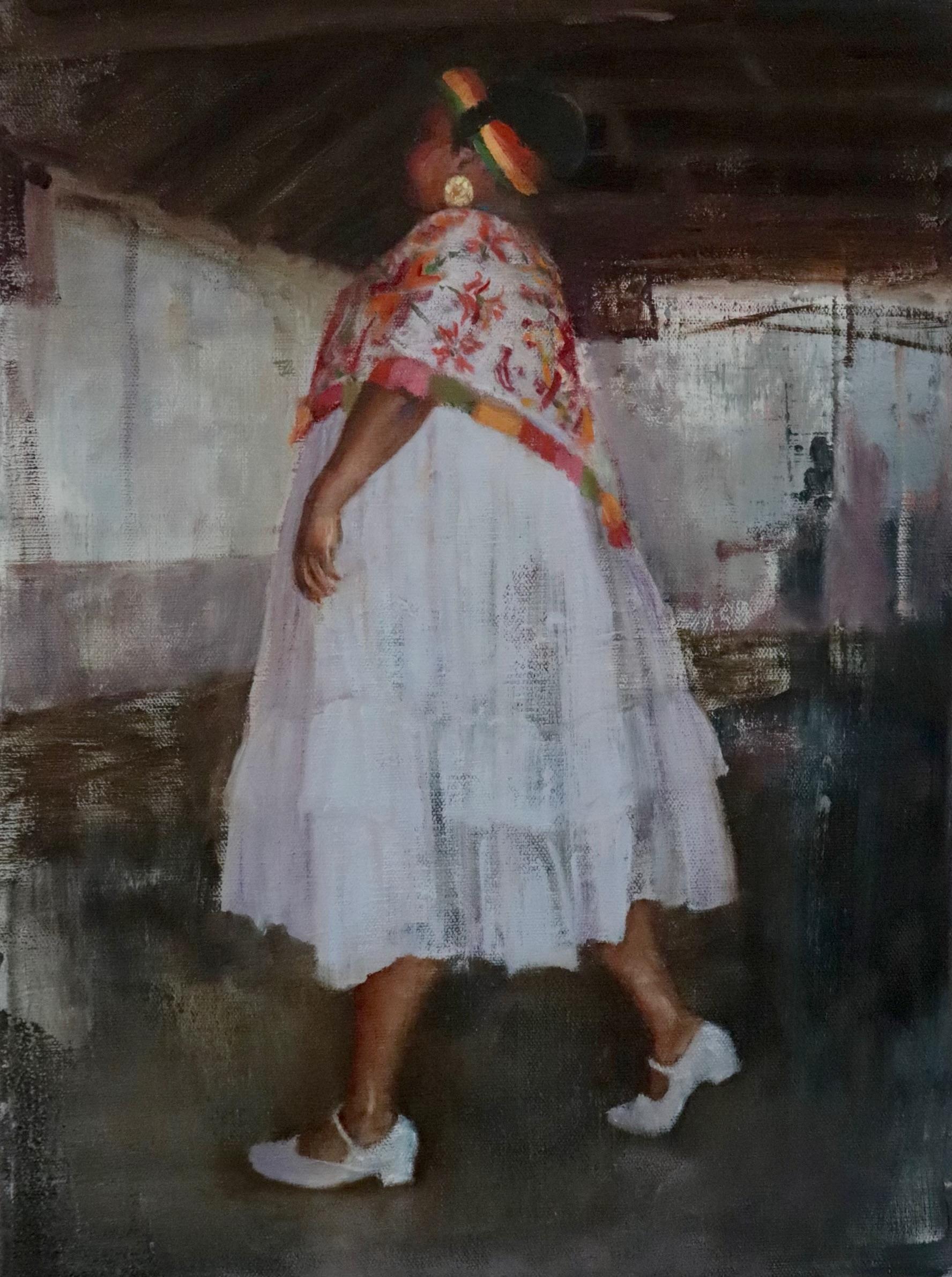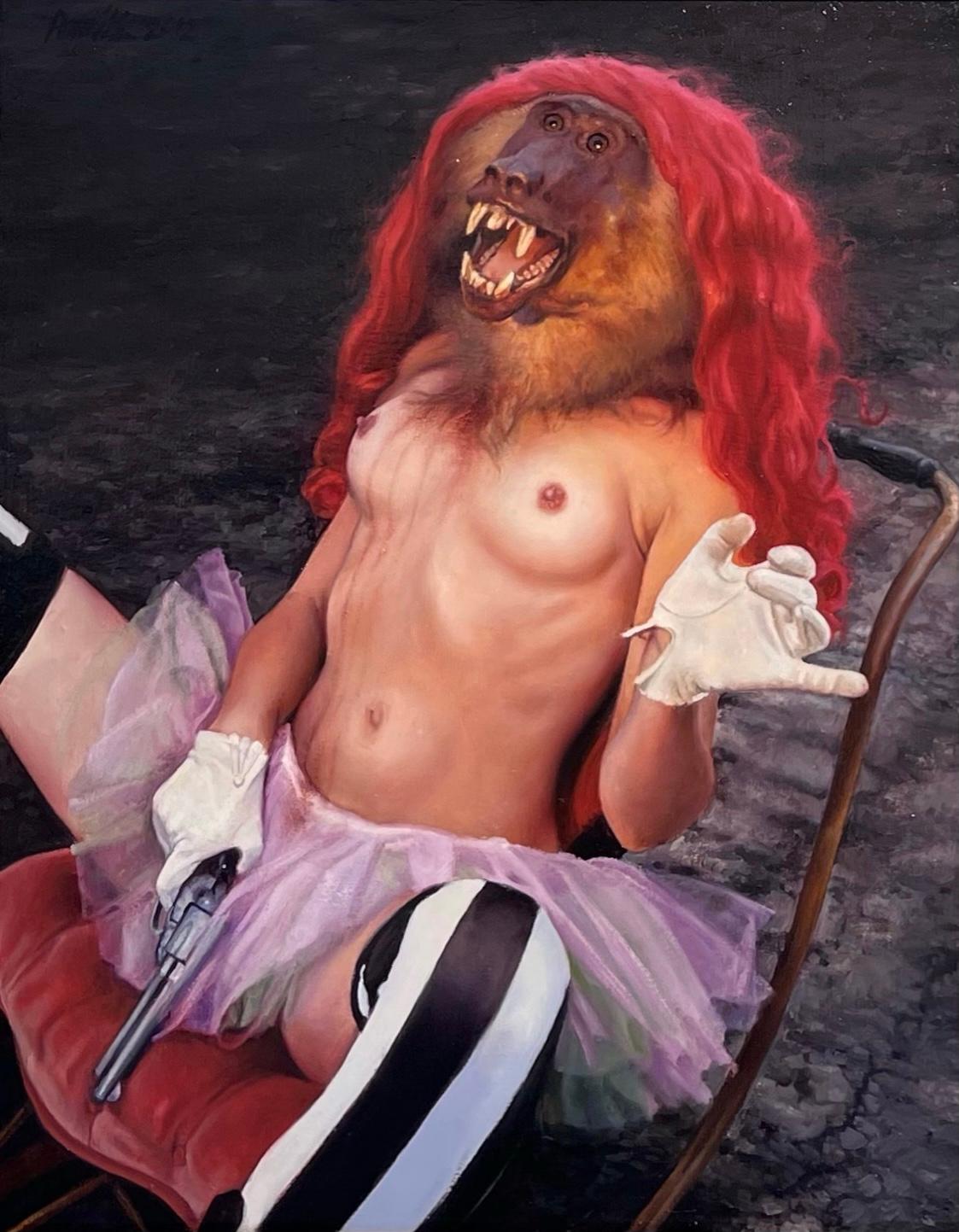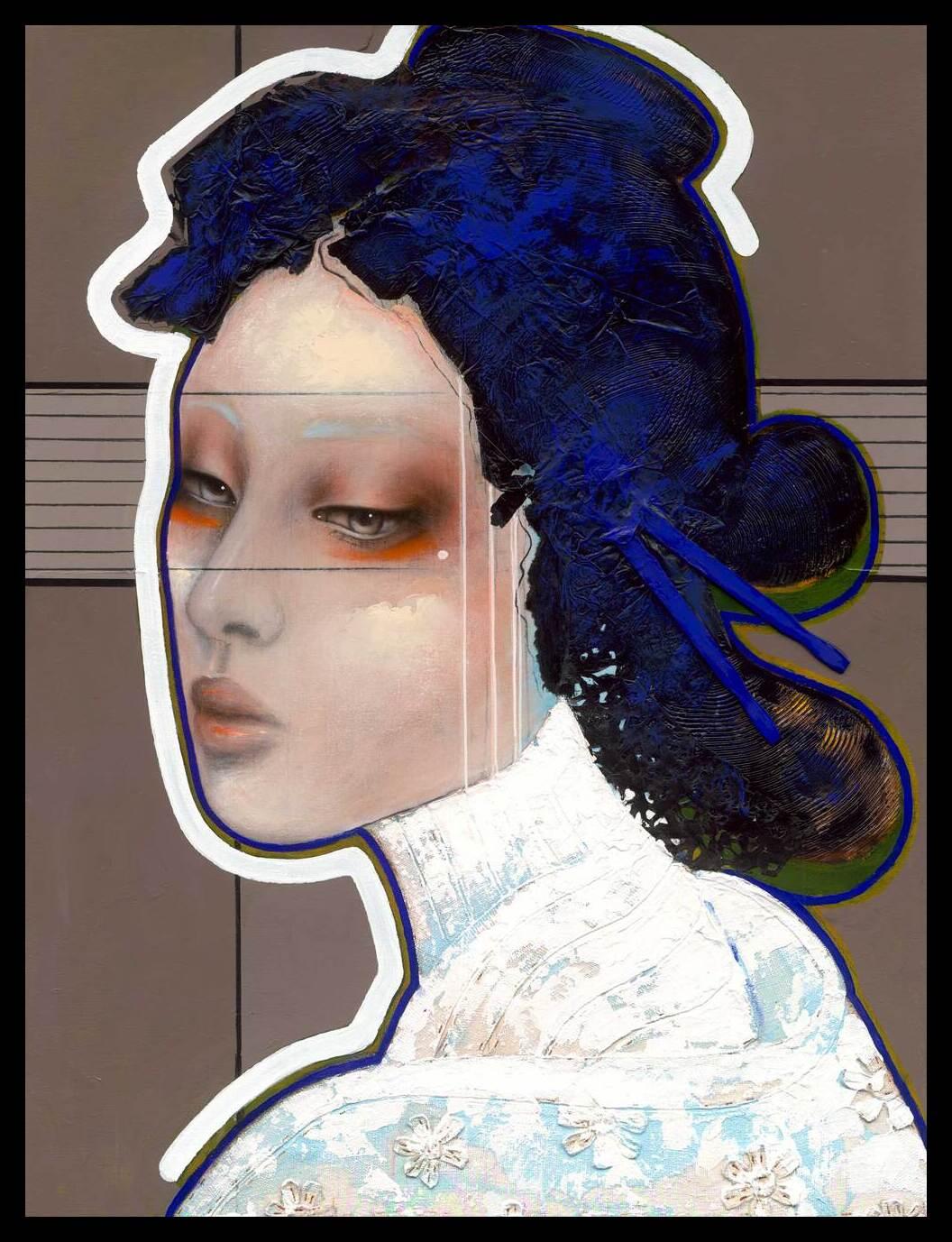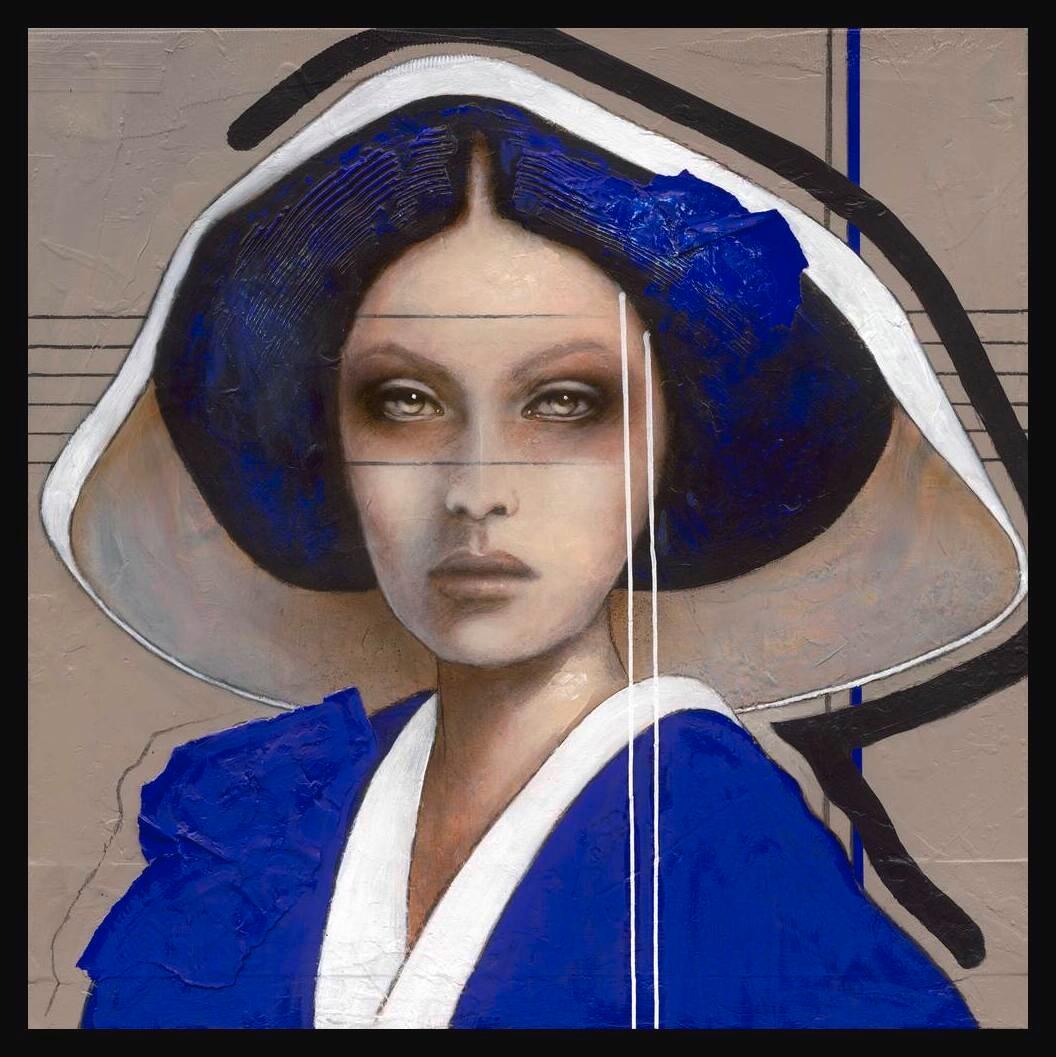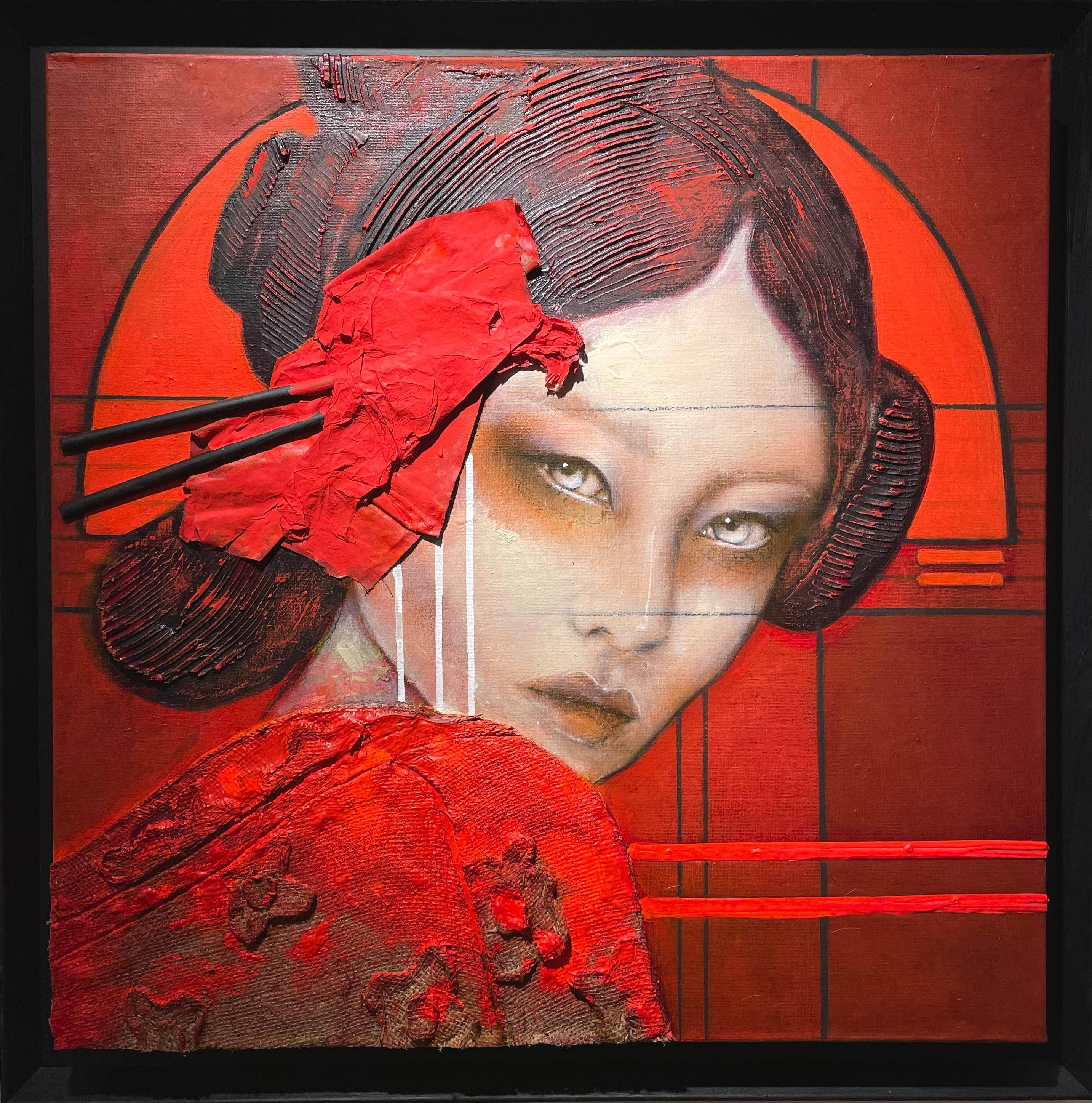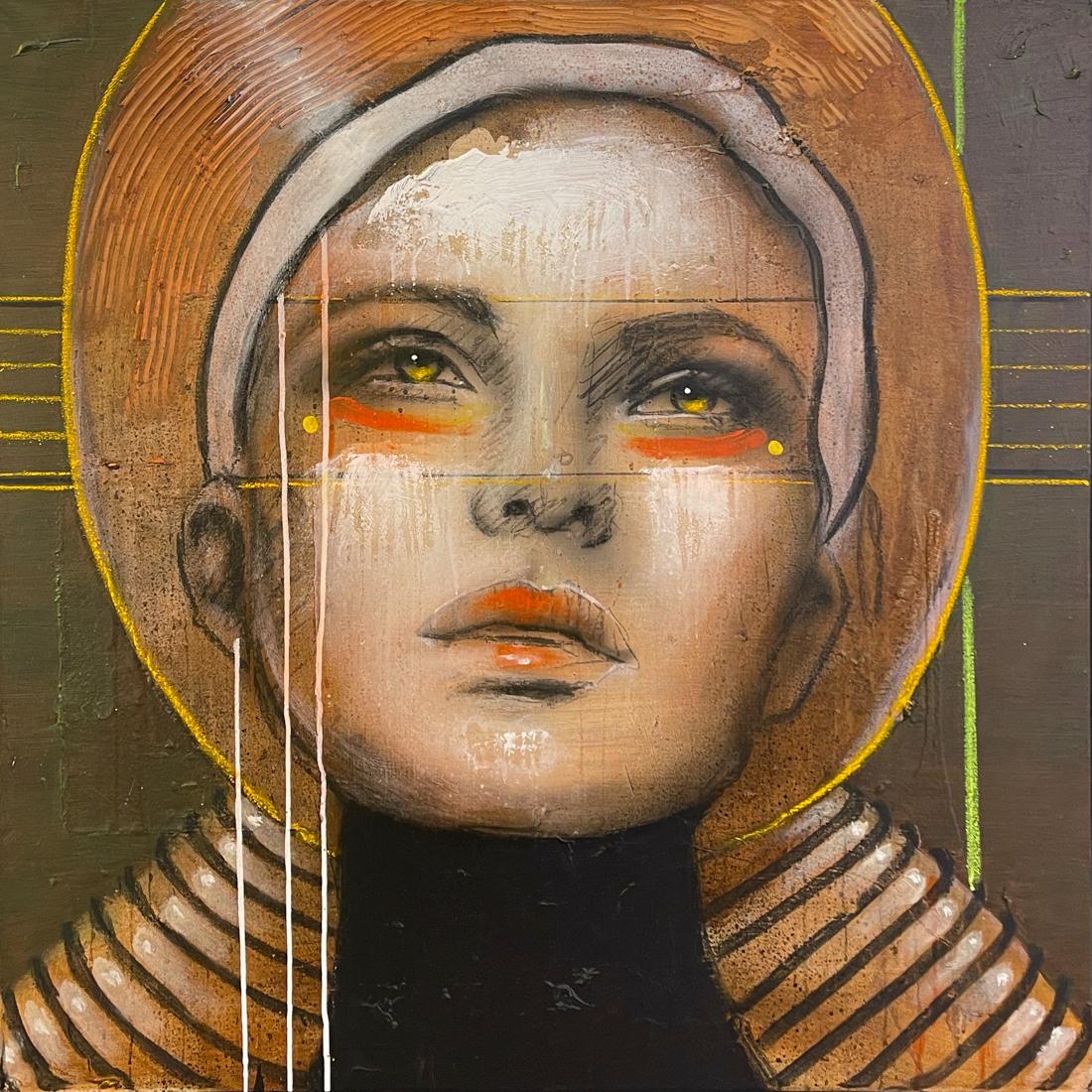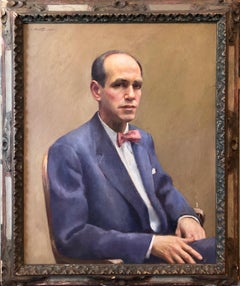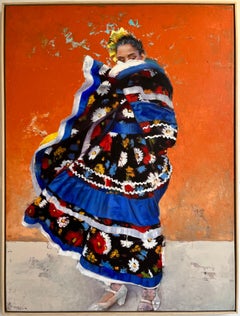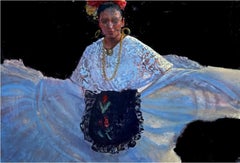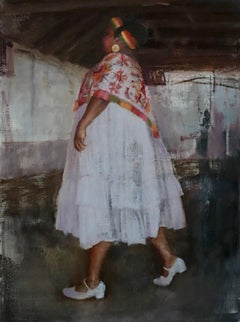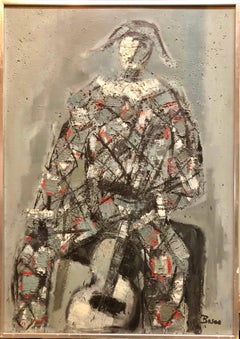
Harlequin, Circus Performer Modern French Oil Painting
View Similar Items
Pierre BoscoHarlequin, Circus Performer Modern French Oil Painting
About the Item
- Creator:Pierre Bosco (1909 - 1993, French)
- Dimensions:Height: 37 in (93.98 cm)Width: 26 in (66.04 cm)
- Medium:
- Period:
- Condition:size includes frame. frame has some wear.
- Gallery Location:Surfside, FL
- Reference Number:1stDibs: LU3822845823
Pierre Bosco
Pierre Bosco was a member of the famous Italian Della Rovere family born in Visco, the province of Udine, Italy. At an early age, he developed an interest in art. His ever-growing interest in paintings took him to Genoa and then Rome, where he became a religious paintings restorer, learning the secret techniques of the great masters of art. Bosco’s early works already showed a natural sensitivity to color and a willingness to give volume to images, which became his artistic signature. When he first discovered paintings of Cézanne, Pissarro, Gauguin and Rouault, he became convinced that his future was in Paris, where the "bohemian" lifestyle attracted painters and sculptors from around the world. At 22, he decided to leave his native Italy and move to Saint-Germain-en-Laye, where he diligently attended the schools and painting workshops of the capital. He met his neighbor, Maurice Denis, and then some of the most well-known artists, such as Pierre Bonnard, André Derain, Aristide Maillol, Edouard Vuillard and his brother-in-law, the Nabi painter Ker-Xavier Roussel, who became his great spiritual master and with whom he discovered his artistic personality. The war years were difficult for the artist. In 1940, he befriended the painter André Marchand and managed to make a living by selling occasionally and with the help from his family. However, he had his first solo exhibition in Paris in 1943 at the Galerie Roussel, boulevard Saint-Germain, but continued to pursue his work austerely in the silence of his studio. When his father died in 1945, the painter returned to Italy to be with his family for some time after 15 years of absence.
After this homecoming, he returned to Paris in 1946, painting and making a living as an art restorer. He finally gained success and recognition in the 1950s. In Saint-Germain-en-Laye, he created the Independent Painters’ Association (API), which gathered painters like Jean Souverbie, Roger Chastel, the Vera brothers, Clave, Gomery and Edoardo Samartino. After participating in the first “Biennale del Mare” in Genoa, he exhibited his work at the Gallery Vivet in Paris in 1952. In 1953, he participated in the Third Sacred Art Exhibition at the Paris Museum of Modern Art, where his painting Descent from the Cross received high praise. The following year, he exhibited 50 paintings at the Galerie du Hérisson in Saint-Germain-en-Laye to an enthralled public, especially Pierre Seghers, a well-known poet and publisher. The French press attributed the paintings of this period to “bewitching magic.” On the occasion of this exhibition, Bosco met the poet Guy Lavaud. According to him, Bosco was a powerful painter and a visionary. For three consecutive years, the painter was selected for the prestigious Otto Friez price at the Museum of Decorative Arts in Paris. In 1955, the Gallery M. Forein in the Faubourg Saint-Honoré invited Bosco for an abstract art exhibition. After careful thought, he refused to participate. At a time when abstract art was emerging into the School of Paris, influencing young painters like Alfred Manessier, Pierre Tal Coat, Jean Bazaine and many others, Bosco explored pure abstraction, but he realized that he ended up making more or less the same paintings with this form of art. For an artist in search of new experiences, abstract art is "an easy way to be locked in a system.” However, abstract art continued to be part of his work but mainly in his works on paper.
In 1956, Bosco met Alex Maguy, a famous collector and owner of the Galerie de l'Elysée. The 45-year-old painter had reached a maturity that was appreciated by a large public of art connoisseurs. He signed a contract that bound him to this art dealer for 15 years, then prepared a major exhibition for the following year. The press was unanimous, praising his "dazzling visions.” Robert Vrinat, a journalist for Le Figaro newspaper, considered him "as one of the greatest painters of his generation.” Americans even saw him as "the latest Picasso in perspective, and very much in vogue" (New York Herald, May 14, 1957). In 1957, Bosco was well known to the affluent elite of the French capital. He appeared in numerous laudatory articles written by famous poets like Pierre Seghers, Jean Cocteau and Marcel Sauvage — who dedicated a poem to him — including the French poet and novelist Henri Bosco, and the journalist and writer Louis Nucéra. Bosco’s works of art stood among those of the biggest names in contemporary painting: Chagall, Braque, Picasso, Matisse, etc. This collaboration opened new doors for him; he participated in radio shows and his paintings entered permanent collections of museums. Once introduced to the American Jewish community, Bosco attracted financiers, lawyers, actors and film producers. The exhibition at the Matarasso Gallery in Nice attests to his success in Paris.
In 1959, the Marquis de Langle, an art collector, organized an exhibition at the Galerie Di Meo in Paris, gathering writers, diplomats and high-ranking officers. On this occasion, Bosco met his Royal Highness the Prince of Greece and the Duke of Broglie. In 1960, he married Madeleine Poire and both traveled to New York for their honeymoon and to attend a major exhibition at the Norval Gallery, where all his usual collectors had gathered for the occasion. The New York Herald Tribune praised this event. Thanks to this success, Bosco extended his honeymoon in the northeastern United States. After his return from America, from January 28 to February 16, 1961, the Athénée museum in Geneva devoted a major exhibition to him. Private collectors including Joseph H. Hirshhorn, a wealthy American industrialist and art collector, made several acquisitions. We can also find Bosco’s paintings in the private collection of celebrities, such as the American actor Kirk Douglas — who acquired seven paintings (among them a Harlequin and a Regatta), Robert Mitchum, Jack Palance, Lord Beaverbrook (Sir Winston Churchill’s friend and confident) and former French president Georges Pompidou as well as singers and sportsmen.
Bosco prepared a major solo exhibition in 1963, and it was a great success. On this occasion, several newspapers — such as Le Figaro, Libération, l’Humanité and Paris-Presse — published laudatory articles. In the literary magazine Carrefour, the author stated, “The savage art of Bosco bears its rudeness and its mystery. It is an art of pure expression that is not made to please, of course, but whose sincerity cannot do anything but capture your attention.” Similarly, in Les Lettres Françaises literary magazine, it was written that "Bosco's paintings are filled with a mysterious atmosphere, a tragic expressionism.” In 1964, he exhibited at the Max Bodner gallery in New York; his paintings were presented among those of Marie Laurencin, Picasso, Signac, Pissarro, Renoir and Rouault. At the end of April, he exhibited at the Galerie du Carlton in Cannes. The following year, he presented 40 recent works at the Wamper Gallery in Cologne (Germany). In April 1967, Bosco was awarded the Silver Medal of the City of Paris, and in June he was made Chevalier de l’Ordre des Arts et Lettres (a distinguished award from the French Ministry of Culture). Stéphane, his third son, was born that year. The end of the decade is marked by European exhibitions at the Gallery Il Tibbio in Trieste (Italy) and the Corner Gallery in London. In 1971, he held a major exhibition at the gallery La Belle Gabrielle. In early 1986, Bosco created a mural, a car race, in the lobby of the Bendix Research Plant in Drancy. In the fall of 1986, he exhibited four paintings in the Hippodrome of Longchamp for the Prix de l'Arc de Triomphe, the French prestigious horse race. A prolific artist over his career, Bosco made many paintings, not to mention the innumerable works on paper: pastels, gouaches, watercolors and drawings.
Pierre Bosco occupies a privileged place among American and European collectors, particularly in France and Italy, but also in Scandinavian countries. His works are also found in the permanent collections of museums: Museum of the City of Paris, Tel Aviv (Israel), Caramulo (Portugal), Beaverbrook Art Gallery (NB, Canada) and the United States (Toledo Museum of Art, Hirshhorn Museum and Sculpture Garden, Washington D.C.).
(Biography provided by Robert Azensky Fine Art)- Israeli Oil Painting Ruth Schloss Child, Doll, Wagon, Kibbutz Social Realist ArtBy Ruth SchlossLocated in Surfside, FLLarge magnificent colorful Ruth Schloss oil painting of a child with a wagon with a doll or a baby in a carriage stroller.. Signed in Hebrew size measures 31x43 with frame , 23x35.25 without the frame. (this is being sold unframed). Ruth Schloss (22 November 1922 – 2013) was an Israeli painter and illustrator who mainly depicted neglected scenes such as Arabs, transition camps, children and women at eye-level as egalitarian, socialist view via social realism style painting and drawing. Schloss became Israeli painting’s sensitive, conscious, remembering eye. Ruth Schloss was born on 22 November 1922, in Nuremberg, Germany, to Ludwig and Dian Schloss, as the second of three daughters of bourgeois assimilationist Jewish family well-integrated into German culture. As the Nazis came into power in 1933, her family immigrated to Israel in 1937, and settled in Kfar Shmaryahu, then an agricultural settlement. Schloss studied at the Department of Schloss graphic design at "Bezalel" from 1938 to 1942 alongside Friedel Stern and Joseph Hirsch. She was a realistic painter who focused on disadvantaged people in the society and social matters as an egalitarian. Her realism was thus an “inevitable realism,” motivated by an inner necessity: the need to observe reality as it is. Her painting repeatedly addressed the door pulled from its frame, employing drawing’s unique ability to stop time and prolong the image’s persistence in the retina, she repeatedly committed to paper - in a matter-of-fact, non-evasive manner devoid of mystery – man’s tendency to generate chaos, suffering and pain. Throughout her life, Schloss remained minimalist. Painting about human fate was the main subject of her artworks. Her natural inclination was to describe the darker aspect of human existence. 1930s The Schloss household was characterized by open, liberal spirit, in keeping with the parents’ progressive views. It deeply influenced Ruth’s mental development, as she learned to tie culture and art with sensitivity towards the weak and underprivileged. In Jerusalem, she joined a commune of Hashomer Hatzair in which she shaped her socialist views, which she maintained throughout her long career. 1940s In this period she mainly depicted landscapes of kibbutz and wretched women living hard life, children in huger, older people, refugees. After completing her art studies, Schloss joined a training group at Kibbutz Merhavia in 1942, and after two years moved to Karkur region, the nucleus established Kibutz Lehavot Habashan in the Upper Galilee. Through this time, she fell in love with the surroundings and drew landscapes. They are simple and direct with fresh, lucid lines. These paintings were selected as the main works of her first exhibition in 1949. In early 1945, Schloss started to draw illustrations in the children’s magazine Mishmar Leyeladim, and designed the logo of Al Hamishmar, the paper’s new name in 1948. In 1948, upon the founding of Mapam (United Workers’ Party), she designed her party’s emblem, which became a well-known icon. She kept working as an illustrator for Mishmar Layeladim until 1949. "Mor the Monkey" project yielded financial profits and this income was used for a study trip to Paris for two years. She was succesfull as illustrator however, she had inner conflicts of her identity as witnessed painter toward neglected class in Israeli society. First Exhibition at Mikra-Studio Gallery, 1949 She presented forty drawings on paper in her first solo exhibition, representing a selection of the themes of kibbutz landscape, its lifestyle. Schloss confidently proposed her direction through simplicity without using colors in her drawings. 1950s Between 1949 and 1951, she studied at the Académie de la Grande Chaumière in Paris. She began working in oils, with which she continued throughout the 1960s. The exhibition “Back from Paris” opened in November 1951 at Mikra-Studio Gallery . In 1951 she married Benjamin Cohen, who served as chairman of the national leadership of Hashomer Hatzair Workers Party in Tel Aviv. He was a theoretician and a man of principle, highly esteemed by its leaders who became a professor of history at Tel Aviv University. In 1953, following the Mordechai Oren affair and the publication of Moshe Sneh 's followers from Kibbutz Artzi, she and her husband left the kibbutz and moved to the agricultural farm, Kfar Shmaryahu, where she lived until her death. At a certain point in Israeli history, segments of the socialist movement felt that Israel should become part of the Communist bloc, rather than seek the support of the western world. Because the Schloss couple support of Moshe Sneh’s left-wing party, they had to leave the kibbutz. She loved to depict ordinary women as figurative on her painting without hiding or making up anything. The poet Natan Zach wrote about her works in 1955: “Her motto remains that which has been all these years: life as it is, without bluffing." Schloss’s “Pietà” (1953) became a universal cry expressing the pain of mothers on either side of the divide. In the late 1950s, she was the mother of two daughters. When she drew her daughters, unlike the universal babies she depicted, naked and with clenched fists, the painting of her children employed babyish sweetness to the full in a quiet, peaceful and heart-stirring filling rather than urgency. She also painted children in the transition camp and Jaffa in the 1950s and 1960s. 1960s-1980s – The period of Studio in Jaffa Schloss painted at a studio in Jaffa from 1962 till 1983. In this time, she turned her interest to people around her more than kibbutz – the children, mothers, and poor workers, the alleys and houses. She opened the space to the street and its dwellings, built interactions around it, and was nurtured by the presence of the outside in her work. 1960s Schloss familiarized to an Arab woman, Nabava, lived in poor. Schloss returned to painting images of old people later, and she called her painting figurative elderly people in the old age homes “waiting”. In the late 1960s, Ruth discovered acrylic paint and never turn back to oil painting. In 1965 Schloss devoted a series “Area 9 (1965)”, dedicated to the demolition of Israeli-Arab houses and the expropriation of the land, and carried a definite socio-political messages. The series was exhibited at Beit Zvi, Ramat Gan, in 1966. She was the only artist who addressed the result of the Six-Day War immediately afterward. In 1968, Schloss and Gansser-Markus presented “Drawing of War” in Zurich gallery. She expressed the war as an ultimate expression of destruction and ruin, regardless of victors and vanquished. 1970s In late 1970s Schloss began printing the selected photograph directly on the canvas, posterior reworking it in acrylic. She decided to print her work at Har-El Printers in Jaffa, and these became the surface of her painting. This technique was mainly adopted in two large series: Anne Frank (1979-1980) and Borders (1982). Through this technique she placed the figure of elder Frank next to that of the famous young Frank, and released it at the exhibition at Bet Ariela Cultural Center, Tel Aviv, in 1981. The series touched upon the Nazi Holocaust. 1980s The Lebanon War raised the question of “The Good Fence” and the effect of the war. She dedicated a large series Boarders, one of the most powerful image linked to the series is the figure of Yemenite woman raising her hand. She was the first to raise the Black Panthers demonstration to the level of a social icon. In the 1980s and again in 2000, the Intifada uprisings also led Schloss to the easel to render a good number of representational and symbolic works that in their way denounced Israel's political and military actions. 1990s – 2000s Ruth Schloss never had an exhibition in a major Israeli museum. Her works were presented in private galleries and small museums. The main museums, the Tel Aviv Museum of Art and the Israel Museum, included her works only in group exhibitions, and only in 1991 was her retrospective exhibited at the Herzliya Museum. In the 2000s, Schloss’s metaphors turned into animal kingdom and Bedouins in the south. A huge rhinoceros, birds of prey, and other "bad animals," as Cohen Evron, daughter of Ruth, calls them and "I connected this to the Nazis," said Schloss. Schloss' work after she didn't find human expression able to transmit the endless cruelty she saw in Israel's political mentality. Schloss also continued to follow and collect documentary photographs of destructions of houses from the war, the Intifada, the sequence of her work about ruin from 1949 to 2005, was a cumulative testimony about the painful history of Israel and Palestine. In 2006, a large retrospective exhibition of her work was presented at the Museum of Art in Ein Harod, curated by Tali Tamir. Education 1938-41 Bezalel Art Academy, Jerusalem, with Mordecai Ardon 1946 painting course for Kibbutz Artzi artists with Yohanan Simon and Marcel Janco 1949-51 Académie de la Grande Chaumière, Paris Awards and recognition 1965 Silver Medal, International exhibition in Leipzig, Germany 1977 Artist-in-Residence, The Cité Internationale Universitaire de Paris Selected solo exhibitions 2004 “Micha...Category
Mid-20th Century Realist Figurative Paintings
MaterialsCanvas, Oil
- Sephardic Jewish Men Vibrant Judaica Vintage Oil Painting Israeli Artist GoldmanBy Albert GoldmanLocated in Surfside, FLThis depicts Middle Eastern jewish men of Sefardic descent. At least one appears to be a Rabbi. ALBERT GOLDMAN Born in Alexandria, Egypt in 1922, Albert Goldman started drawing and painting at the age of 8. He began his art education 1936 Art with Italian and Greek artists at the "Atelier", in Alexandria, Egypt; continuing 1956 with Avraham Yaskiel and Zvi Mairovich, Haifa and with Moshe Propes, in Tel Aviv. In 1940 he obtained a diploma of commerce and opted for a career in the hospitality industry, following in the footsteps of his parents who operated the Majestic Palace Hotel in Alexandria. He moved to Cairo in 1942 to study Swiss Hotel Management at Egyptian Hotels Limited, the largest hotel company in the Middle East at the time. In 1946 he decorated an evening gown for an American singer, Catherine Essex, who sang before King Farouk. By 1947 he was the manager of the Luxor Hotel. In 1948, during an air raid over Alexandria, he was attacked by an Arab mob accusing him of signaling Israeli planes. He miraculously survived 12 stab wounds to the back. In March 1950 he married Lucette Blumenthal. He was put on the blacklist by the Ministry of Interior in Egypt, and in 1951 he managed to leave Egypt and came to Israel in September 1951 aboard the ship Artza. In 1956 he attended a drawing and painting course with Meirovich and Avraham Yaskiel in Haifa. He organized the Jerusalem Art Cellar in 1958 and settled in Jerusalem. He paints mostly Israeli landscapes, particularly of Jerusalem. This is done in a style reminiscent of Tully Filmus and Itzhak Holtz. Albert Goldman was born in 1922 in Egypt Awards And Prizes 1983 Bnai Brith Prize, Dan region 1990 Certificate of Registration in the Golden Book of Keren Kayemet LeIsrael Exhibition of Paintings The Municipal Museum - Bet-Emanuel, Ramat Gan Artists: Pinchas Abramovich, Lea Avisedek, Albert Goldman, Shaul Ohaly, Robert Baser, Claire Szilard, Itamar Siani...Category
20th Century Modern Figurative Paintings
MaterialsCanvas, Oil
- Itzhak Holtz (Judaica Master) Oil Painting Portrait John Sloan Ashcan Artist WPABy Itshak HoltzLocated in Surfside, FLOil Painting Portrait of Ashcan Artist John Sloan. Signed I. Holtz. The youngest of four children, Holtz was born and spent his early childhood in Skierniewice, Poland, a small town near Warsaw. His father was a hat maker and a furrier. In 1935, prior to World War II, when Holtz was ten years old, his family moved to Jerusalem, Israel, where they settled in the Geula neighborhood near Meah Shearim. Itzhak Holtz's passion for art began early. When he was five years old, in Poland, his father first drew a picture of a horse and sled in the snow for him. The young Holtz looked at the drawing and studied it in wonderment. From that moment on, Holtz remembers, he constantly begged his father to draw for him. His enthusiasm for art grew and Holtz longed to study art. In 1945, he enrolled at the Bezalel Academy of Art and Design in Jerusalem, where he primarily studied lettering and poster work in a program geared toward commercial art Holtz became interested in painting, prompting him to move to New York City in 1950 to study at the Art Students League of New York under Robert Brackman and Harry Sternberg, and then at the National Academy of Design under Robert Philipp. Holtz has stated that his artwork, which primarily but not exclusively, depict scenes of Jewish spirituality and tradition, is driven by his Orthodox Jewish beliefs: "You have to live that religious life to fully capture it on canvas." He has been classified in the school of genre painting, often depicting street scenes of ordinary people in everyday Jewish life in the back alleys and markets of Jerusalem neighborhoods such as Me'ah Shearim and Geula; and in New York neighborhoods and hamlets such as Monsey, Boro Park and Williamsburg. Along with street scenes, his work includes portraits of scribes, tailors, cobblers and fishmongers, and images such as shtetls, lighthouses, and wedding scenes. He started out painting mostly portraits in order to support his family, before expanding to include street scenes. His beloved subject matter is painting scenes of Jewish life, his childhood memories when his mother took him along shopping for the Sabbath to the markets of Meah Shearim, has left a deep impression on him and influenced many of his works. Holtz has experimented in the abstract, but then reverted to representational and figurative art to which he devoted himself exclusively. His Israeli street scenes are said to combine “an affectionate recollection of the past with the brilliance of the color of modern Israel.” Holtz has stated that he struggled at first when he arrived to the USA because of financial reasons and because he only knew Polish, Yiddish and Hebrew, but then made good ties with his instructor who greatly influenced him Robert Philipp who helped him make friends and referred him to paint portraits. Examples of Holtz's work throughout the years include: Yerusalem Wedding (2010), depicting a Chuppa in Jerusalem on early evening, oil on canvas; The Funeral(1966), depicting five stoic Hasidim carrying a body on a bier over to a gravesite, with the people behind them crying, in charcoal on paper and oil on canvas; Rejoicing (1974), an image of religious men dancing, in felt pen and marker on paper; and the oil painting Shamash Learning in Shul (2003), a portrait of a pious Jew studying the Talmud inside a claustrophobic synagogue scene. Throughout the years Holtz has created hundreds of works in many art mediums, including, genre scenes, portraits, still lifes and landscape scenery, his works are sought after by art collectors worldwide, and he has been called the greatest living Jewish artist. It is said that no artist ever explored the Jewish subject like Holtz. Today some of his oil paintings have been commanding over $100,000. Holtz creates his scenes after researching locations, and often uses locals as models. He paints slowly and with great care, but with a swift Impressionistic style. The people in his portraits and scenes are generally more cheerful and optimistic than standard portraits of Hassidic individuals. He paints oils and watercolors, and also does felt pen, pastel, marker, ink and charcoal drawings, as well as woodcuts. His oil paintings typically have a brown hue, while his work with felt pen is often in sepia tones, and on some of his works he used very bright colors, with a strong emphasis on the interplay of light and shadow. He is heavily influenced by the ancient staircases and alleyways of Jerusalem, with its modest religious population, which has made a strong impression on him in his youth, the streets of Tzfat, and the works of Rembrandt, Johannes Vermeer and Peter Bruegel, as well as Jewish artists Moritz Daniel Oppenheim...Category
1940s Realist Portrait Paintings
MaterialsCanvas, Oil
- Alabama Surreal Folk Art Oil Painting African American Woman, Flower HeaddressBy Maltby SykesLocated in Surfside, FLThe painting is signed Sykes and dated 1960 lower right. It has "Maltby Sykes, 1911- for Leon" written on the stretcher verso It is a Surrealist Folk Art ...Category
1960s Folk Art Figurative Paintings
MaterialsCanvas, Oil
- Pre War European Hasidic Rabbi Portrait German Judaica Oil PaintingLocated in Surfside, FLIt is an oil on canvas wrapped board. size includes frame. Sensitive Portrait of Jewish Chassidic religious scholar at study or prayer. Rare Pre World War II (Pre Holocaust) Judaica Art. European Judaic art...Category
20th Century Impressionist Figurative Paintings
MaterialsCanvas, Oil
- Large French Figurative Expressionist Oil Painting Seated Figure Claude WeisbuchBy Claude WeisbuchLocated in Surfside, FLWEISBUCH, Claude. Oil on Canvas Framed size: 39” H x 28” W Canvas, without frame: 32” high x 21 ¼” wide. Carved wooden frame with antique gold-leaf finish Claude Weisbuch, 1927-2014 French painter, draftsman and engraver. He studied at the Ecole des Beaux-Arts (School of Fine Arts) in Nancy and upon graduation became a professor of engraving at the Ecole des Beaux-Arts de of St. Etienne. His first solo exhibition was in 1957. In 1968 , he became a full member of the Society of French Painters-Engravers . In 1997 he was awarded the Legion of Honor His work is essentially devoted to engraving, by which he likes to translate, thanks to the line, the life, movement and character of his characters: Punchinels, harlequins, musicians or equestrian scenes. He practices various techniques ( lithography, drypoint etching etc.) that he puts to use in the illustration of bibliophile books. Claude Weisbuch is also a painter and draftsman. His favorite colors are ochres, browns and whites, with which he seeks to introduce the effects of light by compositions where the line and finesse of the drawing preserve the life found in his engravings. His precise and dynamic line delivers a moving and swirling work on themes he loves: theater, opera, equestrian, musicians, card players, Kabuki dancers and many portraits. His works have the appearance of unfinished sketches mixing few colors but a great vivacity of the line. He illustrated many limited edition signed fine art books. Alon with Christo, Arman and Cesar he is considered among the great post war French artists of the last generation. Exhibitions 1957: Saint Placide Gallery, paintings and engravings 1958: Galerie de Presbourg, Paris, paintings - Saint Placide Gallery, Paris, paintings - Galerie des Arts, Nancy, etchings 1960: Galerie Hervé, "Extraordinary Pantomimes", Paris, paintings 1961: Salon of the young painting and painters witnesses of their time 1962: O'Hanna Gallery, London , paintings 1963: Galerie Hervé, "Portrait Of Man", Paris, Paintings - Nichido Gallery, Tokyo, Paintings 1965: Hervé Gallery, "100 Drawings", Paris Dresdener Gallery, Toronto, paintings 1966: Dantesca Gallery, Turin , paintings, engravings, drawings 1968: New Vision Gallery, Paris, engravings 1969: Galerie Hervé, Paris, paintings - Galerie Reflets, Brussels , prints, paintings - Galerie Dresder, Montreal , paintings 1970: Taménaga Gallery, Tokyo, paintings - Sagot Gallery - The Garrec, Paris, etchings - Museum of Modern Art of the City of Paris ARC, Paris, prints 5 1971: War Gallery, Avignon , etchings Biennial of Engraving, Epinal 1972: Dantesca Gallery, Turin Festival, Sarlat , paintings 1973: Wayss Gallery, Nancy , paintings, engravings, drawings Auguste Comte Gallery, Lyon , paintings, engravings, drawings Taménaga Gallery, Tokyo, paintings - New Vision Gallery, "Homage to Rembrandt", Paris, etchings 1974: Esthetika Gallery, Kortrijk, engravings - Galerie Hervé Odermatt, Paris, paintings Ésthetika Gallery, Kurne, prints - Galerie Wayss, Nancy, engravings, drawings, pastels Dietesheim Gallery, Neuchâtel , engravings - Grafikhuset Gallery, Stockholm , prints, drawings 1975: Schwarzer Gallery, Vienna , engravings, paintings, drawings Fogola Gallery, Turin, drawings, pastels Sotheby-Parke Benett, Munich, engravings, drawings Hervé Odermatt Gallery, Paris, drawings Joly Gallery, Washington , engraving 1976: Taménaga Gallery, Tokyo, paintings - Wayss Gallery, Nancy, engravings, drawings - Tabula Gallery, Tübingen, engravings, drawings - New Vision Gallery, "The horse-The painter and his model", Paris, drawings, engravings 1977: Grafikhuset, Futura, Stockholm - Jivô Gallery, Vänersborg Pigalle Gallery, Norrköping Celsius Gallery, Uppsala Möbius Gallery, Gothenburg - New Vision Gallery, Jerusalem - Cultural Center of Sainte-Menehould Castle, retrospective, engravings 1978: David Barnett Gallery, Milwaukee , engravings, drawings Orangery Gallery, Cologne , engravings, drawings, pastels Grafikhuset Futura, Stockholm, paintings, drawings Les Cordeliers, Châteauroux, engravings, drawings, paintings House of Culture, Montbéliard, engravings House of Culture, Chelles , engravings, paintings, drawings 1979: L'Empreinte Gallery, Strasbourg, prints, drawings - Galerie Reflets, Brussels, prints, drawings - Galerie Bon à tirer, Los Angeles , prints, pastels 1980: Hervé Odermatt Gallery, Paris, "Calligraphy of the figure", paintings - E. Gollon Gallery, Saint-Paul-de-Vence 1981: European Biennale of Engraving, Baden-Bade Galerie The Art Shop...Category
20th Century Modern Figurative Paintings
MaterialsOil, Canvas
- Nicholas V. Sanchez - La Brisa, Painting 2021Located in Greenwich, CToil on canvas 48” H x 36” W Nicolas V. Sanchez received his BFA from Kendall College of Art and Design in Grand Rapids, MI and his MFA from the New York Academy of Art. While at the...Category
2010s Contemporary Figurative Paintings
MaterialsCanvas, Oil
Price Upon Request - Nicholas V. Sanchez - Veracruz Dancer, Painting 2021Located in Greenwich, CToil on canvas 30” H x 40” W Nicolas V. Sanchez received his BFA from Kendall College of Art and Design in Grand Rapids, MI and his MFA from the New York Academy of Art. While at the...Category
2010s Contemporary Figurative Paintings
MaterialsCanvas, Oil
- Nicholas V. Sanchez - Ballerina de Sol, Painting 2021Located in Greenwich, CToil on canvas 16” H x 12” W Nicolas V. Sanchez received his BFA from Kendall College of Art and Design in Grand Rapids, MI and his MFA from the New York Academy of Art. While at th...Category
2010s Contemporary Figurative Paintings
MaterialsCanvas, Oil
- "The Mooring of Scarlet, " Oil PaintingBy Pamela WilsonLocated in Denver, COPamela Wilson's (US based) "The Mooring of Scarlet" is an original, handmade oil painting that depicts a pregnant model with a boat on top of her head. This...Category
2010s Realist Portrait Paintings
MaterialsCanvas, Oil
- "Metempsychosis: Ginger Snapped, " Oil PaintingBy Pamela WilsonLocated in Denver, COPamela Wilson's (US based) "Metempsychosis: Ginger Snapped" is an original, handmade oil painting that depicts a topless female model with a Baboon head. This is a secondary market...Category
2010s Realist Portrait Paintings
MaterialsCanvas, Oil
- Cafe BreakfastBy Matthew CraneLocated in Buffalo, NYMatthew Crane is a figurative painter whose work seeks to find a balance between violence and grace. As a self taught artist, Matthew merges abstract exp...Category
21st Century and Contemporary Contemporary Figurative Paintings
MaterialsCanvas, Oil


